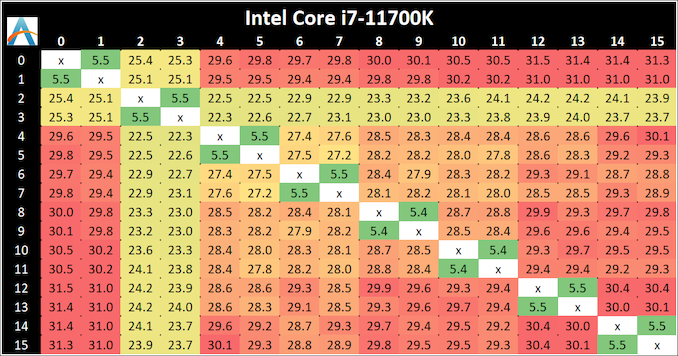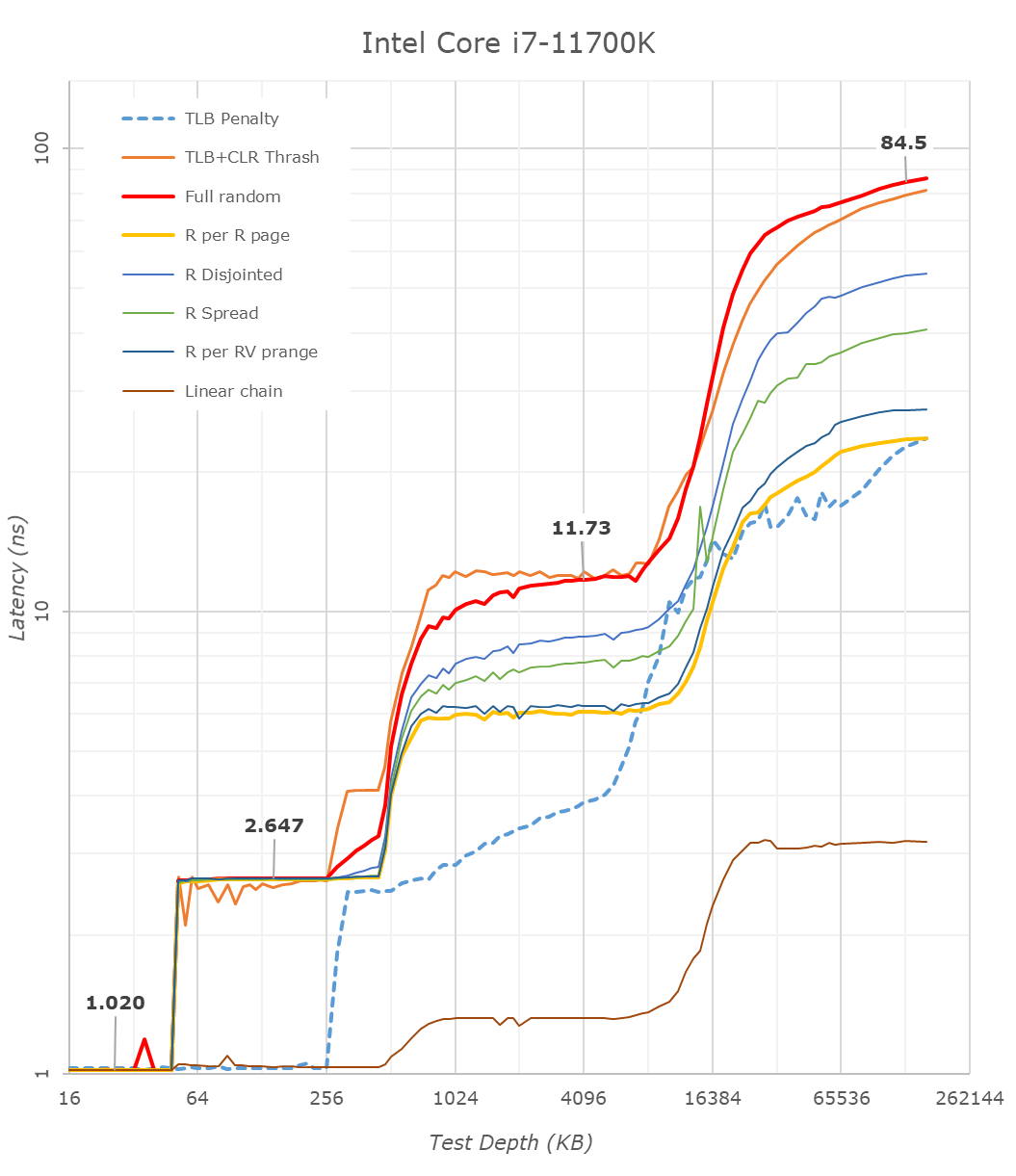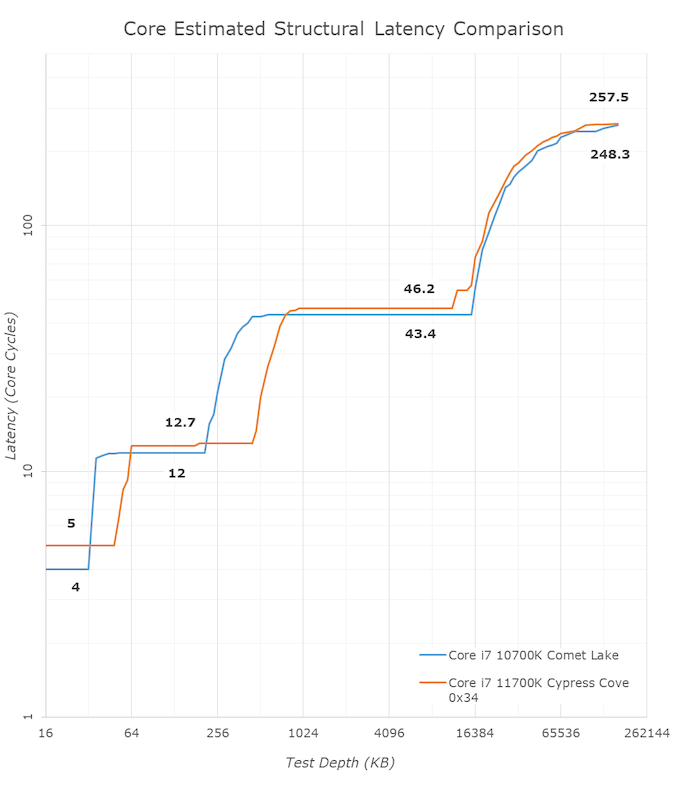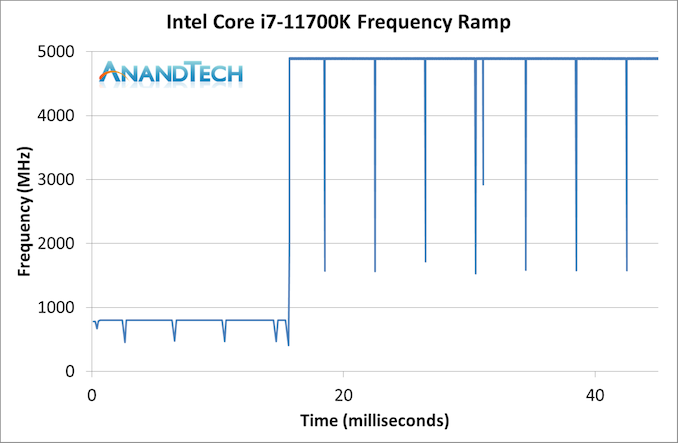Intel Core i7-11700K Review: Blasting Off with Rocket Lake
by Dr. Ian Cutress on March 5, 2021 4:30 PM EST- Posted in
- CPUs
- Intel
- 14nm
- Xe-LP
- Rocket Lake
- Cypress Cove
- i7-11700K
CPU Tests: Microbenchmarks
Core-to-Core Latency
As the core count of modern CPUs is growing, we are reaching a time when the time to access each core from a different core is no longer a constant. Even before the advent of heterogeneous SoC designs, processors built on large rings or meshes can have different latencies to access the nearest core compared to the furthest core. This rings true especially in multi-socket server environments.
But modern CPUs, even desktop and consumer CPUs, can have variable access latency to get to another core. For example, in the first generation Threadripper CPUs, we had four chips on the package, each with 8 threads, and each with a different core-to-core latency depending on if it was on-die or off-die. This gets more complex with products like Lakefield, which has two different communication buses depending on which core is talking to which.
If you are a regular reader of AnandTech’s CPU reviews, you will recognize our Core-to-Core latency test. It’s a great way to show exactly how groups of cores are laid out on the silicon. This is a custom in-house test built by Andrei, and we know there are competing tests out there, but we feel ours is the most accurate to how quick an access between two cores can happen.
The core-to-core numbers are interesting, being worse (higher) than the previous generation across the board. Here we are seeing, mostly, 28-30 nanoseconds, compared to 18-24 nanoseconds with the 10700K. This is part of the L3 latency regression, as shown in our next tests.
One pair of threads here are very fast to access all cores, some 5 ns faster than any others, which again makes the layout more puzzling.
Update 1: With microcode 0x34, we saw no update to the core-to-core latencies.
Cache-to-DRAM Latency
This is another in-house test built by Andrei, which showcases the access latency at all the points in the cache hierarchy for a single core. We start at 2 KiB, and probe the latency all the way through to 256 MB, which for most CPUs sits inside the DRAM (before you start saying 64-core TR has 256 MB of L3, it’s only 16 MB per core, so at 20 MB you are in DRAM).
Part of this test helps us understand the range of latencies for accessing a given level of cache, but also the transition between the cache levels gives insight into how different parts of the cache microarchitecture work, such as TLBs. As CPU microarchitects look at interesting and novel ways to design caches upon caches inside caches, this basic test proves to be very valuable.
Looking at the rough graph of the 11700K and the general boundaries of the cache hierarchies, we again see the changes of the microarchitecture that had first debuted in Intel’s Sunny Cove cores, such as the move from an L1D cache from 32KB to 48KB, as well as the doubling of the L2 cache from 256KB to 512KB.
The L3 cache on these parts look to be unchanged from a capacity perspective, featuring the same 16MB which is shared amongst the 8 cores of the chip.
On the DRAM side of things, we’re not seeing much change, albeit there is a small 2.1ns generational regression at the full random 128MB measurement point. We’re using identical RAM sticks at the same timings between the measurements here.
It’s to be noted that these slight regressions are also found across the cache hierarchies, with the new CPU, although it’s clocked slightly higher here, shows worse absolute latency than its predecessor, it’s also to be noted that AMD’s newest Zen3 based designs showcase also lower latency across the board.
With the new graph of the Core i7-11700K with microcode 0x34, the same cache structures are observed, however we are seeing better performance with L3.
The L1 cache structure is the same, and the L2 is of a similar latency. In our previous test, the L3 latency was 50.9 cycles, but with the new microcode is now at 45.1 cycles, and is now more in line with the L3 cache on Comet Lake.
Out at DRAM, our 128 MB point reduced from 82.4 nanoseconds to 72.8 nanoseconds, which is a 12% reduction, but not the +40% reduction that other media outlets are reporting as we feel our tools are more accurate. Similarly, for DRAM bandwidth, we are seeing a +12% memory bandwidth increase between 0x2C and 0x34, not the +50% bandwidth others are claiming. (BIOS 0x1B however, was significantly lower than this, resulting in a +50% bandwidth increase from 0x1B to 0x34.)
In the previous edition of our article, we questioned the previous L3 cycle being a larger than estimated regression. With the updated microcode, the smaller difference is still a regression, but more in line with our expectations. We are waiting to hear back from Intel what differences in the microcode encouraged this change.
Frequency Ramping
Both AMD and Intel over the past few years have introduced features to their processors that speed up the time from when a CPU moves from idle into a high powered state. The effect of this means that users can get peak performance quicker, but the biggest knock-on effect for this is with battery life in mobile devices, especially if a system can turbo up quick and turbo down quick, ensuring that it stays in the lowest and most efficient power state for as long as possible.
Intel’s technology is called SpeedShift, although SpeedShift was not enabled until Skylake.
One of the issues though with this technology is that sometimes the adjustments in frequency can be so fast, software cannot detect them. If the frequency is changing on the order of microseconds, but your software is only probing frequency in milliseconds (or seconds), then quick changes will be missed. Not only that, as an observer probing the frequency, you could be affecting the actual turbo performance. When the CPU is changing frequency, it essentially has to pause all compute while it aligns the frequency rate of the whole core.
We wrote an extensive review analysis piece on this, called ‘Reaching for Turbo: Aligning Perception with AMD’s Frequency Metrics’, due to an issue where users were not observing the peak turbo speeds for AMD’s processors.
We got around the issue by making the frequency probing the workload causing the turbo. The software is able to detect frequency adjustments on a microsecond scale, so we can see how well a system can get to those boost frequencies. Our Frequency Ramp tool has already been in use in a number of reviews.
Our ramp test shows a jump straight from 800 MHz up to 4900 MHz in around 17 milliseconds, or a frame at 60 Hz.














541 Comments
View All Comments
Makaveli - Friday, March 5, 2021 - link
lol the only one looking like a fanboy is you.DigitalFreak - Friday, March 5, 2021 - link
Why so butthurt? You wouldn't be on here whining if the benchmarks were in Intel's favor. Never understood the fanboi mentality.arashi - Friday, March 5, 2021 - link
Because now his website won't get the views he thought they'd get.Spunjji - Saturday, March 6, 2021 - link
Nice projection there.MarcusMo - Sunday, March 7, 2021 - link
”Using a processor that isn't suppose to be sold is sketchy”The operative word you’re missing is “yet”. The batch of processors this one is from is Intel release silicon intended for end customer hands. And there are more out there. This article represents exactly the kind of performance that at least some day one customers should expect. Now maybe there will be updates to the software stack that will improve performance over time, but that doesn’t make this review any less valid.
Slash3 - Friday, March 5, 2021 - link
Appreciate the statement, Ryan.Pre-release content is nothing new for AnandTech, and it's interesting to see how passionately some people feel about the topic. Might be something worth exploring in a future article, as I'd wager that there are a lot of readers who weren't around to see things like the original Sandy Bridge pre-review which Ian referenced in another reply.
CiccioB - Friday, March 5, 2021 - link
I think the criticism on this review is quite justified.You are reviewing a device that is not ready to be sold yet.
Yes, you could buy it at retail but just because, like you, some other "smart guy" made the wrong (would say fraudolent) move to not respect a date.
What we have here is a "preview" of the CPU performances that may (or not, but you don't know now) change when the CPU will really available for the rest of the mortals on the globe.
I would like to think that you will do a new review of the CPU once the motherboards will be updated and make evidence if, how and by how much something has changed since this preview with what are early samples that results being compatible with the device.
However, while you were at it, you could also try PCI4 connected memory storage to see how good Intel implementation of the technology is.
MFinn3333 - Friday, March 5, 2021 - link
"You are reviewing a device that is not ready to be sold yet." How is it Ian or Ryan's fault that Intel released a CPU in this condition? If Intel isn't doing any QA on their end for proper use out of the box then the problem is on their end.And yes, they did release it in that condition because unless they intend to recall all the packages and open them up and replace the CPU inside, it is the product that people are going to be getting and using when they open it up and slapping it in their computer. I used to work retail and getting new product on major releases is usually about 3-4 weeks ahead.
Following your logic then they shouldn't do a review unless they are willing to also update all of the AMD CPU's as well to include their performance and bug fixes which would turn bench-marking into a never ending nightmare because of updates.
Intel whiffed this release, get over it.
CiccioB - Saturday, March 6, 2021 - link
You have misses that Intel has not released the product yet and the samples you can find on the market come from a seller that broke the NDA and start selling them before the official release time.They are actually are in beta support with BIOS, microcode, drivers and such on not final motherboards as well.
Once you understand that you'll understand why this is a preview or a beta test, not a full review of the product.
Qasar - Saturday, March 6, 2021 - link
um THE HAVE RELEASED THEM. the store just started selling them early, that is the stores fault. you are grasping at straws.